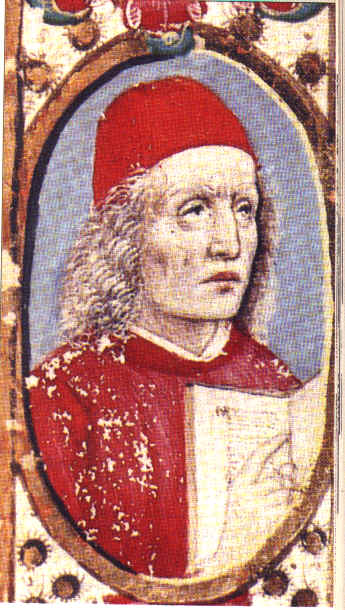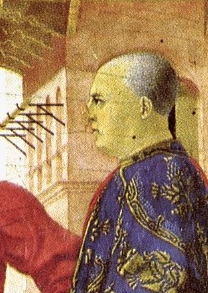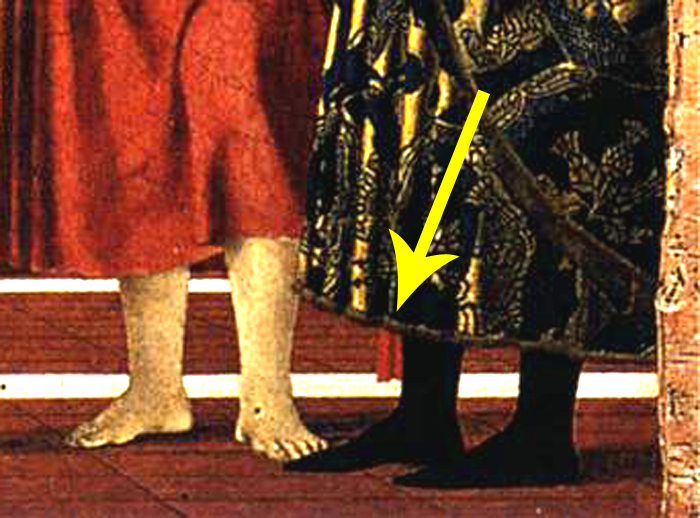The Flagellation of Christ is a painting, tempera su tavola (58.4×81.5 cm) by Piero della Francesca, created around 1453 and conserved in the National Gallery of the Marches of Urbino.

The Flagellation of Christ – tempera on wood (58.4×81.5 cm) by Piero della Francesca – about 1453
In my opinion, from a careful observation of the frescoes of the Sassetti chapel performed by Ghirlandaìo in Santa Trinita in Florence it is possible to recognize the first person left in the foreground in the flagellation of Piero della Francesca, who is Francesco Sassetti (Florence, April 1421 – March 9, 1490) a man of trust of Lorenzo the Magnificent, he was entrusted with the management of his business in France, with the qualifications of manager and attorney.
He first administered the Geneva branch, which was then moved to Lyon, where he invested, together with the Medici and other members, a figure that allowed him to participate in profits.
He then became general manager of the Medici Bank from 1469 until his death in 1490.
Thanks to the attendance of the Medici court he became a cultured and refined man, a friend of Marsilio Ficino, Agnolo Poliziano and Bartolomeo Fonzio.

Confirmation of the Franciscan Order (Confirmation of the Rule) Domenico Ghirlandaio – Sassetti Chapel (1482-1485)
On the right in the foreground are the Gonfaloniere di Giustizia Antonio Pucci, brother-in-law of Francesco Sassetti, Lorenzo il Magnifico, Francesco Sassetti himself and his son Federigo, destined for religious careers.

Confirmation of the Franciscan Order (Confirmation of the Rule) Domenico Ghirlandaio – Cappella Sassetti (1482-1485) detail
The Sassetti portrayed by Ghirlandaio in the chapel of the same name is older than that portrayed in the flagellation of Piero della Francesca but I think it is still recognizable in the facial features, in particular short shaved hair and probably in the mole below the left jaw.

Domenico Ghirlandaio – Sassetti Chapel (1482-1485)
The Sassetti is clearly the commissioner and has this table executed to give it to the Duke of Urbino probably on the occasion of the Council of Mantua of 1459, or diet or congress of Mantua that was convened by Pope Pius II, elected the year before, to organize a Expedition against the Ottomans who had taken Constantinople in 1453. His appeal was addressed to the sovereigns of Europe, to stop fighting each other but to unite against the common enemy of Christianity. The wars in northern Italy had just ended with the Peace of Lodi, but in England the War of the two roses was fought and the war of the thirteen deployed the Prussian cities and the local nobility against the Teutonic Knights, whose support would fundamental state.
I also believe that the hand that made the portrait of Sassetti on the flagellation, does not belong to Piero della Francesca who was not a portraitist as it is deduced from his entire production, and the Sassetti businessman could not tolerate not being recognized immediately by Federico da Montefeltro, Duke of Urbino, to whom a specially painted table in Florence was designed to be donated to him.
Looking carefully at the portraits of the Sassetti in the chapel of the same name we can see that only his work is particularly close to the true compared to the clearly bland work of the other portrayed characters, a tangible sign of the punctual and inflexible character of his personality able to obtain what he wanted and did not overlook the details, qualities that certainly made him rise to the top of the economic and political power of the time.
I also have doubts about the realization of the Sassetti dress painting, evidently rich and of pictorial workmanship that has nothing to do with the realizations of the other clothes and fabrics of the same table.
The second character from the right is Marsilio Ficino (Figline Valdarno, 19 October 1433 – Careggi, 1 October 1499) was a philosopher, humanist and Italian astrologer, a friend of Sassetti.

Marsilio Ficino – miniature
Silio Bozzi, head of the Scientific Police of Ancona, carried out a series of investigations and researches that led to the result that behind the portrait of the young blond would be the philosopher Marsilio Ficino. In fact, according to the directive of the Ancona scientific police, the work could represent the ceremonial initiation of the aforementioned philosopher.
The police, through the use of investigative techniques, in particular of the anthropometric comparison, compared a reproduction of the young blond portrait in the Flagellation with miniatures depicting Marsilio Ficino.

However, the image of the young blond has been preventively aged through the technique of Age Progression.
The comparison of the physiognomy of the two subjects turned out to be positive.
In support of the hypothesis of initiation Bozzi highlighted in the painting a hidden detail depicting the bandage used during the initiation rite.
 The red bandage in question is placed under the dress of the third figure and goes down to the feet.
The red bandage in question is placed under the dress of the third figure and goes down to the feet.

Furthermore, a further element confirming this hypothesis is the particular that the central figure presents the wavy and wet hair as if they had been immersed in water, a purifying element.
In the fascia of the frame, on the right, under the three characters in the foreground, at least until 1839, according to the Passavant one read the inscription “Convenerunt in unum” (“They agreed” or “Allied” most likely the original title of the table ), taken from Psalm II, which is part of the service of Holy Friday, referred to the Passion of Christ: Adstiterunt reges terrae et princes convenerunt in unum adversus Dominum et adversus Christum eius.
Also Luigi Luminati, on Il resto del Carlino of 18 January 2010, in an article entitled Scientific solves the case “Flagellation” – Piero della Francesca and the Pythagoreans, writes that Flagellation would represent “the initiation of the continuer of the neo-Platonic cultural tradition that the Byzantine scholars had brought to Italy in the Renaissance “. Neo-Platonic, we add, and neo-Pythagorean, to the extent that the last Plato is profoundly influenced by Pythagoras.
In the year in which Constantinople is about to fall, “the consecration of Ficino is immortalized as the future heir of Cardinal Bessarione (the only one in history that was also Basileus of the Orthodox Church, Ed.) Two important members of the Pythagorean-Platonic mystery cult introduced in Italy by Gemisto Pletone “.

Bessarione in the series of illustrious men of the Studiolo by Federico da Montefeltro. The painting is housed in the Louvre Museum.
The third character from the right is Cardinal Bessarione (in Greek Βησσαρίων, perhaps Basilio a century; Trebizond, 2 January 1403 – Ravenna, 18 November 1472) was a cardinal and Byzantine humanist.
In 1437 he was appointed archbishop of Nicea and in 1438 he came to Italy with cardinal Cusano, first in Ferrara, then in Florence, to discuss together the numerous Byzantine delegation and the emperor himself, the union of the two Churches, hoping to obtain Western aid against the Ottomans who became increasingly threatening towards Constantinople.
While before the Council of Ferrara Bessarione belonged to the Byzantine party opposed to the union, during the Council it proved to be a proponent of the union of the Roman Church with the Orthodox one. On a philological and theological basis Bessarione demonstrated that a controversial passage in the text of Saint Basil (prominent figure of the Orthodox Church) supported positions equal to those of the Church of Rome, while copies of the text that did not have the offense were all very recent. The main dogmatic question that divided the two Churches was the one called the Filioque, concerning the relationship within the Trinity between the Son, the Father and the Holy Spirit: significant, in this regard, is the debate that, during the Council, occurred between Bessarione and Ludovico da Pirano, present as Bishop of Forlì. But the reasons that divided the two churches were deeper. The ecclesiological and historical-political reasons were so complex and profound that they seemed more difficult to overcome than the dogmatic ones.
This hostility of the Byzantines towards the Latin Christians had begun in 1054, with the mutual excommunication, but it was further deepened after the fourth crusade of 1204, which had destroyed the Byzantine Empire with the conquest and plunder of Constantinople and the division of the Byzantine territories among the powers that had taken part in the “crusade”, especially the Venetians, rather than aiming at the Turks to reconquer Jerusalem. On 6 July 1439, however, due to the explicit will of the Emperor to reach a compromise, the decree of union of the Churches, from Cardinal Cesarini in Latin and from Bessarione in Greek, was read in the presence of Pope Eugene IV and the Emperor himself. .
But what kind of relationship did Marsilio Ficino bind with Cardinal Bessarione?
This is easily understood by retracing the history of those years, which is the story of the collective shock for the imminent fall of Constantinople in the hands of the Turks and the heroic attempt to steal classical culture from destruction.
Bessarione was part of the delegation that came to Italy in 1438, on the occasion of the council held in Florence under Cosimo de ‘Medici in an attempt to heal the schism of the East: on that date, truly epochal for the culture of the West, they arrived in Italy as many as 650 scholars, scholars and clergymen in the wake of Emperor John VIII of Byzantium and of the patriarch of Constantinople Gennadius II.
Back in Constantinople, the Bessarion had to face the hostility of the local population and clergy, until, in 1440, he left the city and moved permanently to Italy. Fallen Constantinople in 1453, Bessarione did all it could to help the Byzantine scholars who had escaped the capture of the Ottomans, thus passing to history as one of the main responsible for the survival of classical culture and becoming a leading figure in world culture.
Among the texts made known to Westerners in 1438 were Plato’s Timaeus and, in all likelihood, the Corpus Hermeticum attributed to Hermes Trismegistus. At that time Ficino was only 5 years old, but it was he who translated the Corpus Hermeticum, by the will of Cosimo de ‘Medici, between 1460 and 1463.
Approaching Ficino al Bessarione, eminent figures in the field of culture and moreover linked both to the mysterious figure of Hermes Trismegistus, is therefore obvious, for anyone who knows a minimum the cultural environment of that period.
Finally, Luminati offers us an interview with Silio Bozzi, during which the director of the Scientific Department makes some revelations even more interesting than those made public in the conference: “Ficino is the passepartout to reveal other symbols: the tradition is Pythagorean and Platonic. At the Accademia di Ficino, there is the assimilation of the new initiate to Christ, the anointed par excellence.The feet and elbow of the young blond are perfectly superimposable to those of Jesus in the background.
There are numerous other esoteric symbols. The staircase of 7 steps in the background; the golden idol has a stick and a sphere like Pythagoras; in the circle under the Christ there is the ‘monad’ worshiped by the Pythagoreans; the eight-pointed star is also in the symbol of Ficino “.